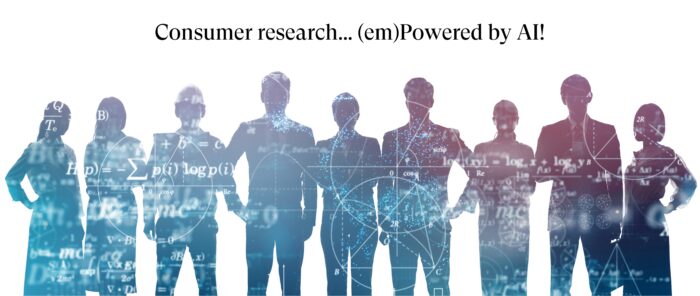Crowst Service
Insights & Industry
29/05/24Embracing AI in Consumer Research
Consumer research has always been the cornerstone of marketing strategies, playing a crucial role in understanding consumer behavior, preferences, and trends. With the advent of artificial intelligence (AI), the landscape of consumer research is undergoing a profound transformation. This article touches upon how AI is reshaping consumer research, its benefits, applications, and potential drawbacks.
Areas of Consumer Research Affected by AI
AI influences several aspects of consumer research, including research design, data analysis and insight generation.
Research design: Designing questionnaires and study structures is crucial for gaining relevant insights that support meaningful decision-making. Experienced researchers understand the necessary and purposeful study types to meet the set objectives. AI tools can assist by initially shaping these designs and suggesting approaches, which researchers can then refine with their expertise.
Data analysis: AI excels in consumer research, especially in data analysis. LLM-based (large language models) AI tools efficiently process and interpret key topics, sentiments, and themes from respondent feedback. When integrated with a company’s social media channels, these tools provide real-time and always-on public opinion insights. Additionally, machine learning models use historical data to predict future buying behavior patterns, aiding in the customization of marketing strategies and forecasting potential outcomes from new developments.
Reporting: AI tools effectively synthesize research and public data to quickly generate insights and recommendations, accelerating decision-making. While researchers still need to apply their expertise to validate these suggestions, AI provides a solid starting point for further exploration.
Benefits of Using AI on Consumer Research
A key challenge for many companies is to manage their cost of research, especially given the challenging macro-economic circumstances in recent years. External research providers, who specialize in different types of research methodologies, analytical capabilities and execution processes, do come at a cost. This coupled with a quickly evolving consumer market, has forced companies to balance their research costs with both internal competencies and external providers. With the proliferation of self-service research tools, more and more companies are bringing some research skills in-house. However, lack of specialized experience also comes with a cost both in terms of efficiency and effectiveness.
This is where AI tools become a valuable asset to both internal and external researchers. For internal researchers, these tools help plug some gaps in competency (to some extent) and allow a more efficient execution process. For external researchers, with improved efficiency brought by such tools, they are able to offer their customers faster services at better costs and augment their current services with new capabilities.
Some of the benefits that AI enables for both internal and external researchers include:
Speed: AI can process vast amounts of data much faster than human analysts, reducing the time from research to action.
Accuracy: Machine learning algorithms can identify patterns and correlations that may be overlooked by human researchers, minimizing biases.
Scalability: AI systems can effortlessly scale up to handle larger datasets as businesses grow.
Cost Efficiency: Automating routine data analysis tasks with AI reduces labor costs and resources.

Cautions of using AI in Consumer Research
Despite its advantages, AI is not without its challenges:
Lack of Human Nuance: AI may miss cultural nuances or emotional subtleties in data that a human analyst would catch.
Over-reliance: Heavy dependence on AI can lead to a lack of critical thinking in interpreting data.
The Public “Data Bias Syndrome”: on models where AI considers vast amounts of publicly available data for analysis, it is important to be aware of the common skew / bias on available data. On many fields there are companies or brands that have a large, disproportionate share of public online content based on past activity. If overlooked, this leads to analysis and findings that may not represent the current reality. Naturally, this calls for human involvement to counter-act possible artificial skews.
No Learning Without Teaching: AI is not equipped by design to learn from its own experience and mistakes. Humans do this by nature, trying not to repeat the same mistakes over and over again. Consequently this means that AI needs to be consistently “taught” to become smarter, which also requires resources.
Ethical Concerns: Issues such as data privacy and algorithmic bias must be vigilantly managed.
At Crowst, we use AI tools for a range of consumer research activities. The Crowst team utilizes AI tools for designing research, analysing data (especially multi-lingual text) and drawing actionable insights. AI tools have been used to develop algorithms and programs that use a consistent analytical methodology across research projects ensuring that insights are reliable and actionable.
Balancing AI and Human Insight
While AI significantly enhances productivity and insight in consumer research, a balanced approach with human oversight is crucial. Humans bring context, creativity, and ethical considerations that AI cannot replicate. Together, AI and human insights can lead to a more nuanced understanding of consumer behavior, driving smarter, more effective business strategies.
AI is a powerful tool that, when used judiciously, can transform consumer research into a more efficient, accurate, and insightful practice. As technology advances, it is imperative for businesses to integrate AI responsibly, complementing rather than replacing the human touch. Furthermore, when AI is adopted, it is crucial to consistently update and educate it, ensuring the advantage it represents will grow over time (versus becoming something that can be considered counter-productive).